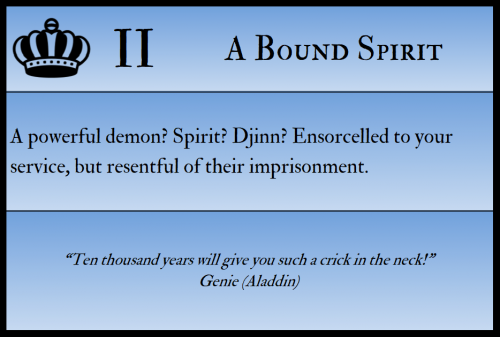Overview
Introduction - Start Here!
Style and Tone
When and Where
Glossary
News
1 | 2 | 3 | 4 | 5 | 6 | 7 | 8
Vig-Net Series
1 | 2 | 3 | 4 | 5 | 6 | 7 | 8
Results
1 | 2 | 3 | 4 | 5 | 6 | 7
Introduction - Start Here!
Style and Tone
When and Where
Glossary
News
1 | 2 | 3 | 4 | 5 | 6 | 7 | 8
Vig-Net Series
1 | 2 | 3 | 4 | 5 | 6 | 7 | 8
Results
1 | 2 | 3 | 4 | 5 | 6 | 7
As the Plucky Heroine drew her Grandmother's Ancestral Broadsword, her Small but Trusty Hound at her side, the Supreme Arch-Dark-Lord sneered.
“I suppose you think to stop me, Viola? This is the Hour of Destiny - even now, the sun falls into A Total Eclipse, and there is nothing you can do to stop me. My Hour of Ascension is at hand! The Stars Are Right! I have slain your Wise Mentor, and married into your friend's Down-At-Heel Noble Family to secure my claim to the Old Family Estate! You could never Strike Me Down!”
“That's what you think, demon - but think again. Who you thought was your Slavering Cultist was Working For Me All Along, and I have studied the Mouldering Tome of your rituals. Oh, and I know now that you were My Long Lost Twin Brother this whole time, so don't even try to use that against me! By my Heroic Will - I swear I will strike you down, Sebastian!”
“Then so be it! I will destroy you, Vi!”
Record of a confrontation between two Muses, identities unknown. This conflict is known to be the highest concentration of Tropes per scene (T/s) on record.
Tropes are small shards of pure narrative, hewn from dream and shaped by unclear processes into physical forms - iconic tools or weapons, stock characters, even well-established plot arcs. They are archetypes that transcend particular stories, recurring over and over in different forms across different stories, imbued with distinctive meanings and significance. Typically, such artefacts are very powerful: while Muses can use their natural Skills and gifts to change Dream around them, and the narratives of Jo's mind set the base conditions of reality, Tropes allow their wielders to directly shift and disrupt the flow of story around them.
Tropology does not replace Skills, Ideals or ordinary objects, but provides an additional boost to their power, versatility, or control of the narrative. You may own a sword, keep a pet cat, come close to dying - but to wield Tropes is something more. Your sword will never be The Ancestral Blade, fated to strike down The Dark Lord; your cat, adorable though she may be, will never be The Hapless Kitten, capable of scampering through the greatest chaos only to be found, licking her paws, atop the rubble; your brushes with mortality will never be A Near Escape, where bullet after bullet whistles past you, tousling your hair in a dramatic and picturesque manner as you laugh at danger.
Many - but not all - Muses have access to a Trope or two, as do a number of Impressions; they are treasured heirlooms, valued tools of the trade or perilous investments against danger. Some wealthy Muses are known to stockpile large numbers of Tropes, using them to store value and barter for other goods and services. The Sell-Out Syndicate efficiently mine even the most mundane Tropes for all they're worth, while NFWS exploration missions discover previously unknown, innovative Tropes in highly experimental Vignettes.
That is not to say that Muses must be either rich or very brave (read: stupid) to get hold of Tropes - but acquiring them does require some degree of skill. Acting out a particularly moving romance in a Vignette might result in The Honourable Proposal, while defeating your sworn enemy could land you There Can Only Be One.
What these Tropes do is often not set in stone, though used either alone or alongside your Skills they will tend to work to your advantage. Used poorly, though, and you may find that your Hapless Minion has betrayed you to your Highschool Rival.
In rules terms, Tropes are a cross between an inventory in a video game and prompts in Improv comedy - they provide one-use power-ups, and ways of asserting direct control around the user used either with or without a Skill. Here are some rules that you should remember when using them:
Though Tropes are wide and varied, there are - it is broadly agreed - four different suits, which are signified by a small symbol in the upper left of the card.
The types of Trope Card are:

Whether we're talking about an Elf or The Retired Badass, these are the archetypal versions of characters. When played, they will take on whatever form makes most sense in their Vignette - though if they're sentient, don't expect them to be too happy if they're completely out of context.
These cards are blue.

From A Fiery Brand to A Suspended Grand Piano, these are generally pretty combat-oriented. That doesn't mean you can't use them in new and innovative ways, but they won't tend to be of much use unless you're trying to bash someone over the head - or something similar.
These cards are red.

A Raging Storm might set the scene, while A Wig Snatch might expose the villain for the fraud they always were. These tend to be for when you want to send the narrative in a new, interesting direction - or simply want to enhance the flavour of what's already there.
These cards are yellow.

Though we might be talking about An Eerie Mask, Objects need not be particularly tangible: A Haunting Melody could be the perfect addition to an otherwise unmoving piece. A miscellaneous selection of everything and anything, they can be used in any way you can think of.
These cards are black.
Some Tropes are more powerful than others - in some cases by a considerable amount. It is broadly agreed that there are four ranks that a card my have, signified by a number in the upper left of the card.
Though much of the effectiveness of a Trope comes down to context and how effectively it has been played, it is broadly accepted that higher ranks will be more influential on the narrative of a Vignette:
Here is an example of a Trope Card:

The crown in the upper left and the blue colour indicates that this is an Archetype, and the number II specifies that this is of rank 2. To the right is the Card's name - in this case A Bound Spirit.
Below is some flavour of what the card represents, and below that is a quote of the Trope being used in a real-world piece of fiction.
(Please note that real-world fiction will not be appearing in the game. The quote is there to give you but one example of how the Trope has been used in real life, and your character will not be aware of it.)